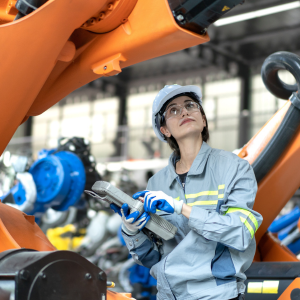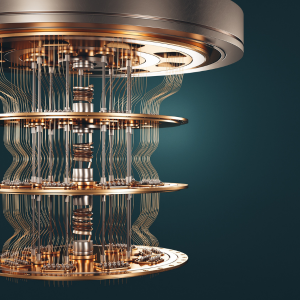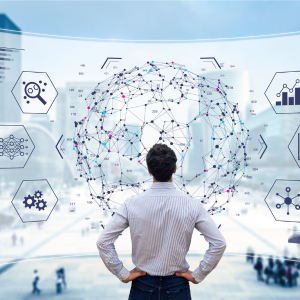What’s The Difference Between Industry 4.0 And Industry 3.0?
Post By: Holly Shaw On: 22-02-2024 - Industry 4.0 - Industry Trends - Manufacturing
To understand Industry 4.0 and Industry 3.0, we must go back to Industry 1.0, although it wasn't called that then. We learned about the Industrial Revolution in school – and there was just one. By achieving a means of driving machinery automatically, the Industrial Revolution changed the whole nature of production.
It occurred in Great Britain between 1760 and 1830, then spread through Europe and the United States. This is now the First Industrial Revolution, or Industry 1.0. As far as the actual words go, the term "industrial revolution" was first used in 1799 and was taken up in the early 1800s.
The second significant advance – Industry 2 – started around 1850, with electricity and large-scale industrial processing. It lasted until the second half of the 20th century.
Computer Age
The third industrial revolution transformed our lives once we got into computers and electronic communications. We began using computers for everything, including the automation of production and assembly lines, although human involvement was still generally required for control. Information Technology (IT) became the next big thing. This step was retroactively called Industry 3.0. It saw a massive upswing in the industrial use of computers as human tasks were phased into automated ones. Programmable Logic Controllers (PLCs), IT and human-machine interfaces (HMIs) replaced humans in governing computerised processes.
Since 2011, Industry 4.0 has encompassed many of the advanced systems we're familiar with. In Industry 4.0, most automated systems follow pre-set programming parameters. They can also streamline production processes by analysing and acting on collected data.
The industrial Internet of Things (IoT), cloud computing, and cyber-physical systems (CPS) impact today's manufacturing processes. These technologies have hugely enhanced automation and global connectivity. The sequence of increased automation has also led us to AI and robots.
Industry 3.0 -> 4.0
The developments in industrial technology offer great benefits, such as:
-
Decentralised information
-
Real-time data collection
-
Big data analytics
-
AI and ML (machine learning)
-
Interoperability
-
Heightened flexibility
Decentralised Information
Many elements of the production process now contain sensors that collect a continuous stream of information. In Industry 3.0, each company's local servers usually store and manage all the data from an individual system. Only limited data sharing and integration took place across sectors. Industry 4.0, however, is just the opposite. Its interconnected platforms and systems allow data to be accessed in real time by multiple stakeholders.
Real-Time Data Collection
Vast quantities of data are being gathered, processed and acted on in real-time. The availability of decentralised information and its immediate analysis has several advantages. It helps to optimise production and management processes, allows different entities to collaborate more effectively, and thus enables better decision-making. Strategies like predictive maintenance considerably reduce downtime.
Big Data Analytics
Big data has had a significant impact on operational efficiency. We can now analyse and assess many aspects of production and business factors, such as customer feedback and returns. These and many other contributing factors can help to improve decision-making, anticipate future demands and reduce outages. Big data enables businesses the flexibility to adapt to current market demand.
AI And ML
The sheer volume of intelligent data collected in today's processes is beyond the capacity of humans. The data analysts of Industry 3.0 have been replaced with Industry 4.0's AI and ML algorithms. Not only can these systems manage big data, but they can learn from its analysis how to improve all aspects of automation. This leads to greater productivity, better quality and overall efficiency. Industry 4.0 integrates automation with intelligence, allowing machines and systems to become more intelligent, autonomous, and adaptive.
Interoperability
Industry 3.0 made significant advances in manufacturing technology, but its main focus was automating existing processes. It was also confined to individual businesses, each with its systems. Industry 4.0 is about collaboration and connectivity between stakeholders in a business ecosystem. These may include manufacturers, their customers, suppliers, and even the machines themselves. The intention is to promote a "collective intelligence" amongst entities who share their knowledge and insights to drive improvement and innovation. Thus, different value chain components collaborate in an ecosystem with complete transparency, seamless communication and interoperability.
Heightened Flexibility
Industry 3.0 adopted the concept of lean production, saving money by automating and streamlining processes. Industry 4.0 is geared instead towards brilliant production, where decisions are made based on data rather than experience. Automated systems learn from the amassed data, optimising operations and making predictions without human intervention. New revenue streams are being created differently. This links systems to the product instead of the process. They are making production processes more flexible and responsive. This allows them to adapt better and faster to market conditions and changing demands.
So, How Does Industry 4.0 Differ From Industry 3.0?
Industry 3.0 achieved limited technological advances in manufacturing, with computers, automation and PLCs. Industry 4.0 leverages far more advanced technologies through the IIoT, cloud computing, augmented reality, and robotics. Add to these AI, ML and big data analytics, and you have real-time connectivity, autonomous systems, predictive maintenance and data-driven decision-making. In addition, the physical and virtual worlds can be merged to enhance many design and manufacturing processes.
Industry 3.0 was all about automation in individual factories. It aimed to save money by improving efficiency and productivity. It optimised production lines by substituting machines and computers for human labour. Industry 4.0 has a much broader scope, integrating digital technologies into the value chain. Interconnected CPS can even manage distribution and customer interaction. This makes the digital transformation of the industry far more comprehensive. We're in a major shake-up of how things work – not just processes but business models and value creation. As Industry 4.0 gathers momentum, we need new skills for the latest technologies. At this stage, we need digital capabilities to be integrated into every organisational aspect of a business.
Get More From Rowse Straight To Your Inbox




